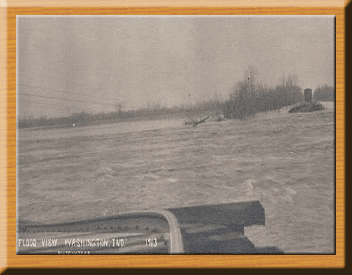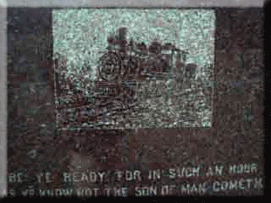

On March 27, 1913 a B&O work train with at least 26 men on board was moving eastward over the Blue Hole trestle (about 1 1/4 miles west of Washington) when the flood waters collapsed the trestle. Old engine number 401 let out a whistle, a little toot, the wheels turned over once, the bell sounded and diaster struck. It sounded like a red hot poker hitting the water when the boiler fire flooded and the boiler crown sheet sizzled in the raging flood. The engine broke through the weakened bridge and the front end went in, onto the box car it was pushing ahead. The man riding on the cow catcher was killed right then. The plunge pulled cross ties and some of the rail off of the surviving portion of the structure. Remaining rails just hung over the swirling waters. Engine 401, its tender and a flat car were dumped into the raging waters at 11:04pm. When the trestle collapsed, most of the train became uncoupled leaving two flat cars and a box car on the rails. Six men were on the engine when it overtuned and fell into Blue Hole, four of them drowned in minutes. One man riding on the flat car was plunged into the flood waters but managed to save himself by swimming to the embankment and pulling himself up onto the track.
Calls were placed to near-by Maysville and a quickly mustered rescue party began to look for survivors and the bodies of the brave men who plumeted off the Blue Hole Trestle. About 30 minutes after the Blue Hole trestle collapsed and one and one-half hours before the two missing men were rescued, diaster struck again. The bridge over the West Fork of the White River located just over a mile west of Blue Hole collapsed and thereby trapped more than 20 men, who had been riding the rear cars of the wrecked train between the two washouts. The men waded out using the rails of the spur track as a guide enabling them to reach the highest point in the area which was Tom's Hill. (Tom's Hill was the location of a switch that had been in use at one time for an old mill. They used barges to ship the grain down the White River from the mill at Tom's Hill). Men waded in water up to their shoulders and most fortunately, managed to avoided many drop offs in the treacherous waters. They found refuge in the house up on Tom's Hill and a huge bonfire was built hastily. The refugees were given hot coffee and their clothing dried. They spent the rest of the night waiting for daylight and a rescue party. About midnight the C&EI bridge at Rogers Station on the East Fork of the White River also collapsed. The relief train arrived about 1:40am and the engine that had fallen into Blue Hole was still burning. The roar of the rushing waters, the smouldering red light from the burning car plus the two faint calls for help heard from far out over the water ... created a scene that the first hand witnesses told and re-told for decades.
Locomotive No.401 was found by professional divers on April 6, 1913. The first attempt at raising the engine failed because the chains that the divers attached to the engine broke during the lifting effort. The engine was eventually raised, repaired, and restored to service on August 1, 1913, at a cost of $2,500.*

** obtained from The Daviess County History book written by Mr. Rex Myers.